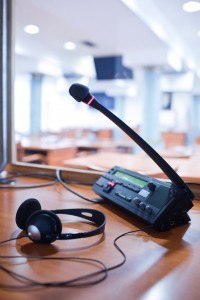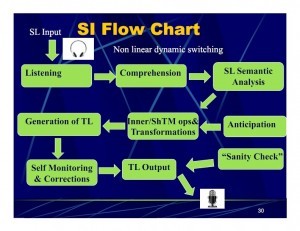This is the question clients sometimes ask during or after a conference.
 Simultaneous interpretation is, indeed, one of the most complex types of language activity. The interpreter is wearing a headset and is repeating in a different language (called “target language”) what he can hear in the original (“source”) language.
Simultaneous interpretation is, indeed, one of the most complex types of language activity. The interpreter is wearing a headset and is repeating in a different language (called “target language”) what he can hear in the original (“source”) language.
There is a certain lag, called decalage in technical parlance. It may be between a fraction of a second and several seconds.
This sort of language interpretation is extremely stressful and taxing. The level of stress is sometimes compared to the stress air traffic controllers experience. Why would anyone want to do it?
As we tell our students, who study conference interpretation, “interpreting is a contact sport”: some people skydive and bungee-jump, interpreters enjoy the thrill of being in the booth and the adrenaline rush it gives.
The simple desire to do it, however, is not enough. And if you ever tried to repeat simultaneously a text even in the same language, you may recall, how much concentration it requires to do it without any mistakes. Now, add to that a different language, technical terminology, an unfamiliar topic and some strange accent the speaker has, and you will see that long and arduous training is required.
Master degree courses in simultaneous conference interpretation are at least 2 years long, and on top of the skill itself you also have to study the culture of the countries, their customs, history, current events, and the most common topics, which you will be interpreting in the professional booth: politics, economics, science and technology, protection of the environment are just a few.
A good simultaneous interpreter is, therefore, a very rounded and integrated individual, who knows a lot, is self-aware and “present”.
Another quality of any professional simultaneous interpreter is what we call “inner speed”: temperamentally slow or sluggish people will probably not make it in this profession. To some degree this quality of “inner speed” may further be developed during training.
Ability to concentrate is another absolutely mandatory requirement. That is to concentrate immensely for a long period of time.
Simultaneous interpreters work in shift of 30 minutes, and during your shift you may easily interpret 4, 500 words. It would take a translator over 2 full days to translate them in writing. And this is only one 30 minute shift during one work day.
And, finally, dividing your attention between several tasks. To the delegate, who is listening to our interpretation, our interpretation seems to be happening at the same time (hence the term “simultaneous interpretation”, please, never call it “simultaneous translation”, it is incorrect).
The mechanism behind simultaneous interpretation is, however, a little bit different. There is a lot of micro-tasks that interpreters are faced with: listen to the original text, understand it, extract meaning, convey the meaning into a different language, make sure that what you are saying is correct, recall previous relevant passages in the same text, recall reference materials you have read on this topic and terminology, or your previous experience, or background knowledge.
Naturally, all these things cannot be happening at the same time, they are happening is a very quick succession. The secret to successful simultaneous interpretation, therefore, is to “shuffle” all these tasks in your mind as quickly as possible without leaving anything important behind.
This chart for more technically inclined illustrates some of these processes and how they fit together:

SL – source language, TL – target language, SI – simultaneous interpretation, ShTM ops – short term memory operations
We can see that, because of its complex nature, professional simultaneous interpretation should never be done by people without appropriate training and skills.
The number of experienced reliable simultaneous interpreters in each language combination is relatively limited, and your interpreting services agency has the responsibility to find the best simultaneous interpreters available on the market for your conference or event.
If you are interested in more details about simultaneous interpreting, please, see Teaching Simultaneous Interpretation forum on LinkedIn.

